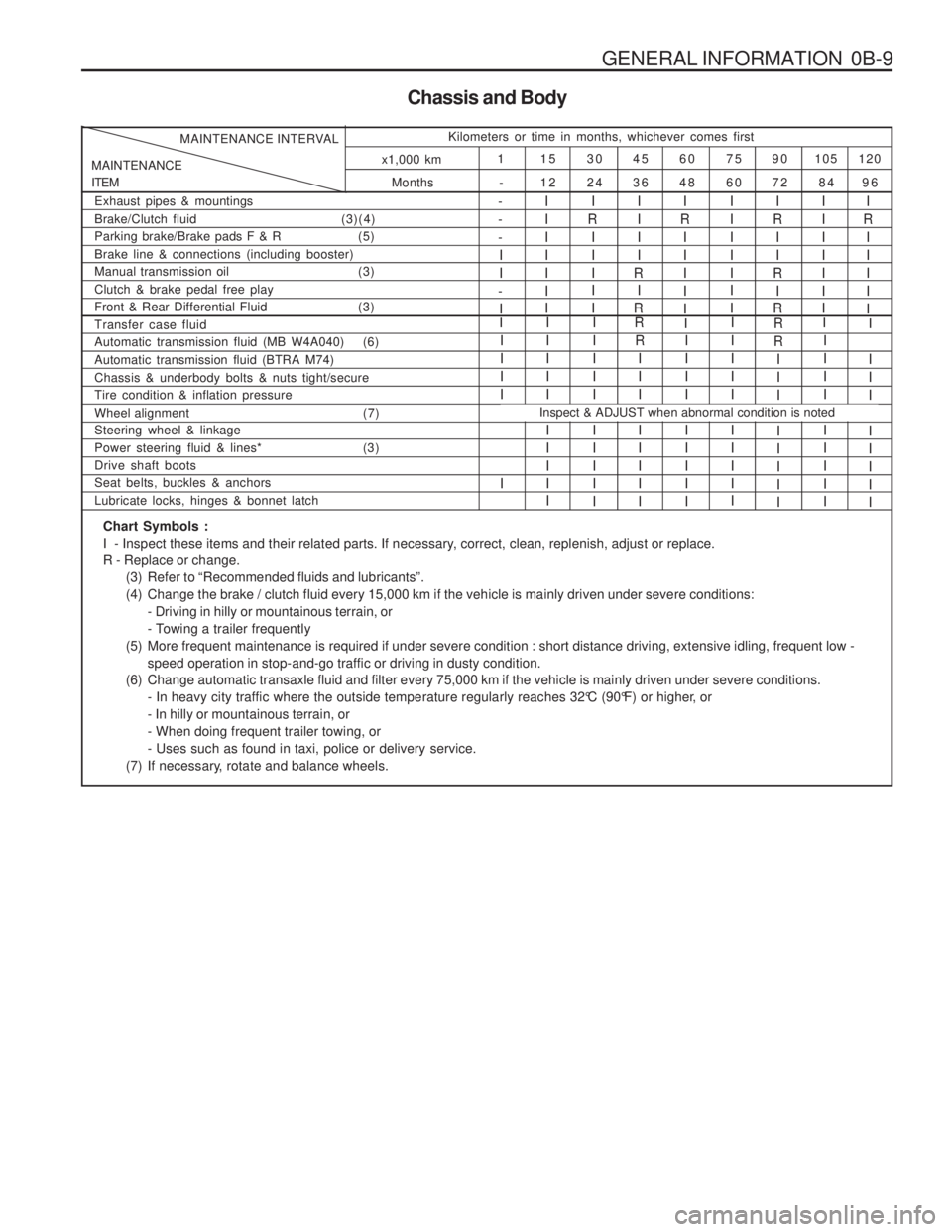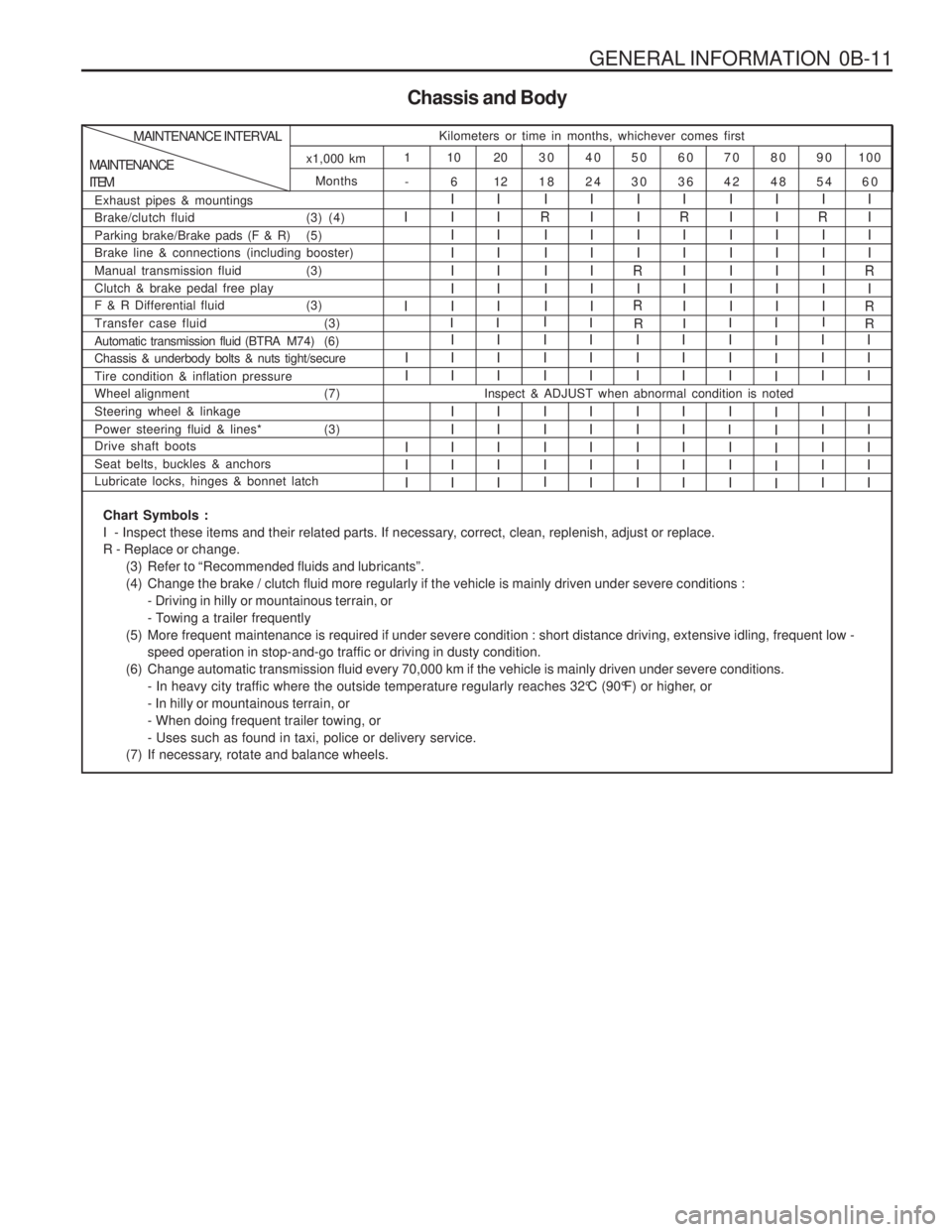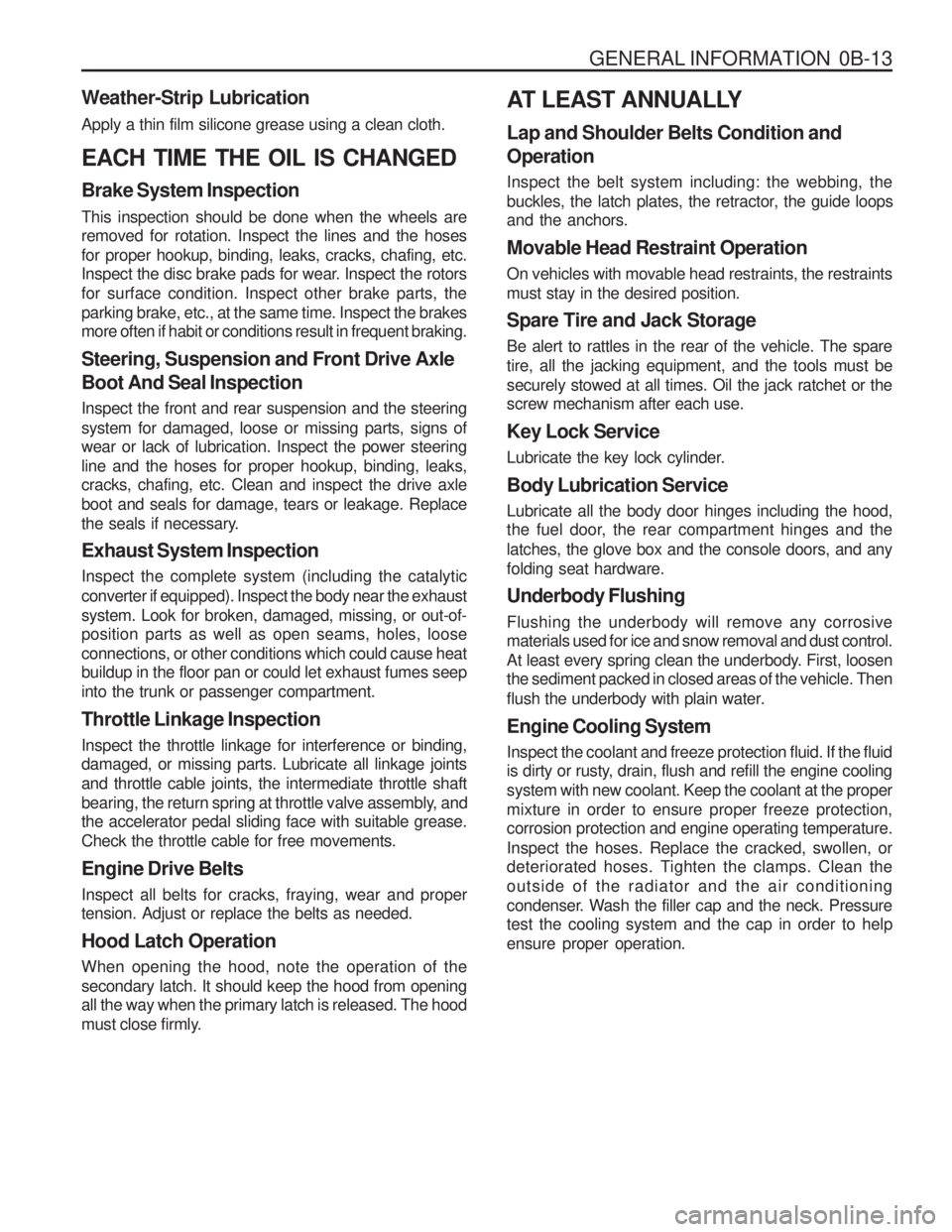ECU SSANGYONG MUSSO 2003 Service Manual
[x] Cancel search | Manufacturer: SSANGYONG, Model Year: 2003, Model line: MUSSO, Model: SSANGYONG MUSSO 2003Pages: 1574, PDF Size: 26.41 MB
Page 9 of 1574

GENERAL INFORMATION 0B-9
Chassis and Body
Months
MAINTENANCE ITEM MAINTENANCE INTERVAL
Kilometers or time in months, whichever comes first
120
105
90
75
60
45
30
15
1
96
84
72
60
48
36
24
12
-
x1,000 km
Exhaust pipes & mountings Brake/Clutch fluid
(3)(4)
Parking brake/Brake pads F & R (5)Brake line & connections (including booster)
Manual transmission oil (3) Clutch & brake pedal free play
Front & Rear Differential Fluid (3)I
R
IIIII- --II
-
I IIIIII I
I
R I II I I IIII
R I
R IIIII I II
R
II
R I
R IIIIII II
R I IIII
Automatic transmission fluid (MB W4A040) (6) Automatic transmission fluid (BTRA M74)Chassis & underbody bolts & nuts tight/secure Tire condition & inflation pressure
Wheel alignment (7) Steering wheel & linkage
Power steering fluid & lines* (3)Drive shaft boots Seat belts, buckles & anchors Lubricate locks, hinges & bonnet latchIIII I I IIII I III I I IIII I IIII
R
III I IIII IIII I IIIIIIIII I III I
R R
III I IIII IIII I IIII
Transfer case fluidRII
I
Inspect & ADJUST when abnormal condition is noted
I
I II I IIII
Chart Symbols :
I - Inspect these items and their related parts. If necessary, correct, clean, replenish, adjust or replace.R - Replace or change.
(3) Refer to “Recommended fluids and lubricants”.
(4) Change the brake / clutch fluid every 15,000 km if the vehicle is mainly driven under severe conditions:- Driving in hilly or mountainous terrain, or
- Towing a trailer frequently
(5) More frequent maintenance is required if under severe condition : short distance driving, extensive idling, frequent low - speed operation in stop-and-go traffic or driving in dusty condition.
(6) Change automatic transaxle fluid and filter every 75,000 km if the vehicle is mainly driven under severe conditions. - In heavy city traffic where the outside temperature regularly reaches 32°C (90°F) or higher, or- In hilly or mountainous terrain, or- When doing frequent trailer towing, or- Uses such as found in taxi, police or delivery service.
(7) If necessary, rotate and balance wheels.
Page 11 of 1574

GENERAL INFORMATION 0B-11
Chassis and Body
Months -
MAINTENANCE ITEMMAINTENANCE INTERVAL
Kilometers or time in months, whichever comes first
100
90
80
70
60
50
40
30
20
10
1
60
54
48
42
36
30
24
18
12
6
x1,000 km
Exhaust pipes & mountings
Brake/clutch fluid (3) (4)
Parking brake/Brake pads (F & R) (5) Brake line & connections (including booster)
Manual transmission fluid (3)Clutch & brake pedal free play
F & R Differential fluid (3)
I I I IIIIIIIIIIIII I
R
IIIII IIIIIII IIII
R I
R I
R
IIIII IIIIIIIIIIIIII I
R
IIIII IIII
R I
R
Automatic transmission fluid (BTRA M74) (6) Chassis & underbody bolts & nuts tight/secure Tire condition & inflation pressure
Wheel alignment (7) Steering wheel & linkage
Power steering fluid & lines* (3) Drive shaft boots Seat belts, buckles & anchors Lubricate locks, hinges & bonnet latchI II I IIII III I IIII IIII I III I
I II I IIII III I IIIIIII I IIII III II II III I IIIIIII I IIII
Transfer case fluid (3)
RI R
I
I
I
I I I II IIII I IIII
Inspect & ADJUST when abnormal condition is noted
II I
Chart Symbols :
I - Inspect these items and their related parts. If necessary, correct, clean, replenish, adjust or replace.R - Replace or change.
(3) Refer to “Recommended fluids and lubricants”.
(4) Change the brake / clutch fluid more regularly if the vehicle is mainly driven under severe conditions :- Driving in hilly or mountainous terrain, or
- Towing a trailer frequently
(5) More frequent maintenance is required if under severe condition : short distance driving, extensive idling, frequent low - speed operation in stop-and-go traffic or driving in dusty condition.
(6) Change automatic transmission fluid every 70,000 km if the vehicle is mainly driven under severe conditions. - In heavy city traffic where the outside temperature regularly reaches 32°C (90°F) or higher, or- In hilly or mountainous terrain, or- When doing frequent trailer towing, or- Uses such as found in taxi, police or delivery service.
(7) If necessary, rotate and balance wheels.
Page 13 of 1574

GENERAL INFORMATION 0B-13
Weather-Strip Lubrication Apply a thin film silicone grease using a clean cloth. EACH TIME THE OIL IS CHANGED Brake System Inspection This inspection should be done when the wheels are removed for rotation. Inspect the lines and the hoses for proper hookup, binding, leaks, cracks, chafing, etc.
Inspect the disc brake pads for wear. Inspect the rotors for surface condition. Inspect other brake parts, theparking brake, etc., at the same time. Inspect the brakes more often if habit or conditions result in frequent braking. Steering, Suspension and Front Drive Axle Boot And Seal Inspection Inspect the front and rear suspension and the steering system for damaged, loose or missing parts, signs of wear or lack of lubrication. Inspect the power steering line and the hoses for proper hookup, binding, leaks, cracks, chafing, etc. Clean and inspect the drive axle boot and seals for damage, tears or leakage. Replace
the seals if necessary. Exhaust System Inspection Inspect the complete system (including the catalytic converter if equipped). Inspect the body near the exhaustsystem. Look for broken, damaged, missing, or out-of- position parts as well as open seams, holes, loose connections, or other conditions which could cause heat buildup in the floor pan or could let exhaust fumes seep into the trunk or passenger compartment. Throttle Linkage Inspection Inspect the throttle linkage for interference or binding, damaged, or missing parts. Lubricate all linkage joints and throttle cable joints, the intermediate throttle shaft
bearing, the return spring at throttle valve assembly, and the accelerator pedal sliding face with suitable grease. Check the throttle cable for free movements. Engine Drive Belts Inspect all belts for cracks, fraying, wear and proper tension. Adjust or replace the belts as needed. Hood Latch Operation When opening the hood, note the operation of the secondary latch. It should keep the hood from opening all the way when the primary latch is released. The hood
must close firmly. AT LEAST ANNUALLY Lap and Shoulder Belts Condition and Operation Inspect the belt system including: the webbing, the
buckles, the latch plates, the retractor, the guide loops and the anchors. Movable Head Restraint Operation On vehicles with movable head restraints, the restraints must stay in the desired position. Spare Tire and Jack Storage Be alert to rattles in the rear of the vehicle. The spare tire, all the jacking equipment, and the tools must besecurely stowed at all times. Oil the jack ratchet or the screw mechanism after each use. Key Lock Service
Lubricate the key lock cylinder. Body Lubrication Service Lubricate all the body door hinges including the hood,
the fuel door, the rear compartment hinges and the latches, the glove box and the console doors, and anyfolding seat hardware. Underbody Flushing Flushing the underbody will remove any corrosive materials used for ice and snow removal and dust control.
At least every spring clean the underbody. First, loosen the sediment packed in closed areas of the vehicle. Then
flush the underbody with plain water. Engine Cooling System Inspect the coolant and freeze protection fluid. If the fluid
is dirty or rusty, drain, flush and refill the engine cooling system with new coolant. Keep the coolant at the propermixture in order to ensure proper freeze protection, corrosion protection and engine operating temperature. Inspect the hoses. Replace the cracked, swollen, or
deteriorated hoses. Tighten the clamps. Clean the outside of the radiator and the air conditioning
condenser. Wash the filler cap and the neck. Pressure test the cooling system and the cap in order to help ensure proper operation.
Page 86 of 1574

1B1-50 M162 ENGINE MECHANICALInstallation Notice
�Make sure the crankshaft bearing cap properly seated in place in the crankcase side. When perfectly installed,the projected part (arrow) locates in the left side (intakemanifold side).
� Assemble so that the projected part of the cap andcrankcase face the same direction.
Removal & Installation Procedure
1. Unscrew the connecting rod bearing cap bolt and remove
the bearing cap. Installation Notice
2. Unscrew the crankshaft bearing cap bolts and separate the upper and lower bearing shells and thrust washers. Installation Notice
�Remove the bearing cap from front (pulley side) to rear.
� Make sure that the upper and lower bearing shells do not change each other and coat with engine oil.
� The oil grooves (arrows) in the thrust washers must faceoutward and insert the thrust bearing into the bearingcap.
� There are five kinds of thrust washers by thickness. Selectthe proper washer when repaired.
3. Remove the crankshaft.
4. Installation should follow the removal procedure in the reverse order.
5. After completion of the installation, check for the rotating condition of the crankshaft.�
Make sure that the upper and lower bearing shells do
not change each other.
� Coat the bearing shell with engine oil.
� Install the bearing cap according to the consecutive
number.
Part No. : 601 030 00 622.15 mm
Part No. : 601 030 01 62 2.20 mm
Part No. : 601 030 02 62 2.25 mm
Part No. : 601 030 03 62 2.30 mm
Part No. : 601 030 04 62 2.40 mm
Tightening Torque 40 Nm + 90 °
Tightening Torque 55 Nm + 90°
Page 101 of 1574

M162 ENGINE MECHANICAL 1B1-65
Adjustment Procedure
1. Position the No.1 cylinder to BTDC 30° .
2. Remove the chain tensioner.
3. Remove the exhaust camshaft sprocket.
4. Align the intake and exhaust camshaft flange hole with the cylinder head upper surface.
� Intake Side : 3 o ’clock direction
� Exhaust Side : 9 o ’clock direction
5. Secure the intake and exhaust camshaft.
6. Position the piston of No.1 cylinder at TDC (OT) by turning the crankshaft.
7. Turn the camshaft adjuster of the intake camshaft to the left as much as possible (cam adjuster ‘retarded ’ position).
8. Install the chain to the intake camshaft sprocket.
Notice
Timing chain must be placed on the guide rail in gear case
cover.
Tools Required 104 589 01 01 00
Spanner
Inspection
1. Position the No.1 cylinder piston to TDC (OT) by turning the crankshaft. Notice When the OT mark on vibration damper is aligned with timing
gear case cover, the intake and exhaust cam of cylinderwill make the slope to the center and will face up. In this
way, the adjustment hole of the intake and exhaust camshaft will match in line with the cylinder head upper end, at 3
o’clock, and 9 o ’clock direction each other.
2. Check the timing as below procedure; - Check if the camshaft adjustment hole is positioned to 3 o’clock direction at the intake side and to 9 o ’clock
direction at the exhaust side, respectively and align withthe cylinder head mating surface.
- At this condition, check if the OT mark on vibration damper aligns with the marker on the timing gear case.
Page 105 of 1574

M162 ENGINE MECHANICAL 1B1-69
8. Install the lever pusher (11) and the thrust piece (8) to theslide (9).
13. Remove the valve cotter (2) using either the pincette (13) or magnetic finger. Lever Pusher 111 589 18 61 00
Magnetic Finger 116 589 06 63 00
9. Mount the thrust piece (8) vertically to the valve spring
retainer (3).
10. Make the thrust piece (8) and the slide (9) perpendicular to each other.
11. Secure the slide (9) by turning the adjust bolt (10).
12. Press the valve spring (4) by using the lever pusher (11).
14. Remove the upper retainer (3) and the valve spring (4).
15. Remove the valve stem seal and replace if necessary.
Notice
Check the valve stem seal and replace if necessary.
16. Remove the lower retainer (6).
NoticeCheck the retainer for damages and replace with a new
one if necessary.
17. Installation should follow the removal procedure in the reverse order.
Page 209 of 1574

M161 ENGINE MECHANICAL 1B2-57
Installation Notice
�Make sure the crankshaft bearing cap properly seated
in place in the crankcase side. When perfectly installed, the projected part (arrow) locates in the leftside (intake manifold side).
� Assemble so that the projected part of the cap and
crankcase face the same direction.
Removal & Installation Procedure
1. Unscrew the connecting rod bearing cap bolt and remove
the bearing cap. Installation Notice
2. Unscrew the crankshaft bearing cap bolts and separate the upper and lower bearing shells and thrust washers. Installation Notice
�Remove the bearing cap from front (pulley side) to
rear.
� Make sure that the upper and lower bearing shells do
not change each other and coat with engine oil.
� The oil grooves (arrows) in the thrust washers must
face outward and insert the thrust bearing into the bearing cap.
� There are five kinds of thrust washers by thickness.
Select the proper washer when repaired.
3. Remove the crankshaft.
4. Installation should follow the removal procedure in the reverse order.
5. After completion of the installation, check for the rotating condition of the crankshaft.�
Make sure that the upper and lower bearing shells do
not change each other.
� Coat the bearing shell with engine oil.
� Install the bearing cap according to the consecutive
number.
Part No. : 601 030 00 622.15 mm
Part No. : 601 030 01 62 2.20 mm
Part No. : 601 030 02 62 2.25 mm
Part No. : 601 030 03 62 2.30 mm
Part No. : 601 030 04 62 2.40 mm
Tightening Torque 40 Nm + 90 °
Tightening Torque 55 Nm + 90°
Page 215 of 1574

M161 ENGINE MECHANICAL 1B2-63
Removal & Installation Procedure
1. Turn the crankshaft and position the n0.1 cylinder piston atATDC 20 °.
Notice
Turn the crankshaft in the direction of engine rotation.
2. Remove the cylinder head front cover.
3. Put the alignment marks (arrows) on the camshaft sprocket and the timing chain.
4. Insert the insert pin into the no.1 and no.6 bearing cap hole on camshaft to secure intake and exhaust camshaft.
5. Remove the chain tensioner.
6. Unscrew the exhaust sprocket bolt and remove the exhaust camshaft sprocket. Installation Notice
Tightening Torque 1st step 20 Nm
2nd step 90
°
Notice The flange bolt is designed to be used only once, so always replace with new one.
Page 219 of 1574

M161 ENGINE MECHANICAL 1B2-67
Tools Required
000 589 01 10 00 Box Wrench Insert104 589 01 01 00Spanner
Removal & Installation Procedure
1. Turn the crankshaft and position the no.1 cylinder piston at ATDC20 °.
2. Put the alignment marks (arrows) on the camshaft sprocket
and the timing chain.
3. Remove the chain tensioner. Installation Notice
Tightening Torque 40 Nm
72 - 88 Nm
Screw Plug
Tensioner Assembly
4. Remove the exhoust camshaft sprocket. Installation Notice
Tightening Torque 1st step 35 - 45 Nm
2nd step 85
° - 95 °
Notice The sprocket bolt is designed to be used only once, so always replace with new one.
5. Take off the timing chain from intake camshaft sprocket, and secute it not to fall down into the timing gear case.
6. Using the wrench (7), turn the camshaft until there is no resistence in camshaft bearing area.
Page 226 of 1574

1B2-74 M161 ENGINE MECHANICAL8. Install the lever pusher (11) and the thrust piece (8) to the slide (9).
13. Remove the valve cotter (2) using either the pincette (13) or magnetic finger. Lever Pusher 111 589 18 61 00
Magnetic Finger 116 589 06 63 00
9. Mount the thrust piece (8) vertically to the valve spring
retainer (3).
10. Make the thrust piece (8) and the slide (9) perpendicular to each other.
11. Secure the slide (9) by turning the adjust bolt (10).
12. Press the valve spring (4) by using the lever pusher (11).
14. Remove the upper retainer (3) and the valve spring (4).
15. Remove the valve stem seal and replace if necessary.
Notice
Check the valve stem seal and replace if necessary.
16. Remove the lower retainer (6).
NoticeCheck the retainer for damages and replace with a new
one if necessary.
17. Installation should follow the removal procedure in the reverse order.